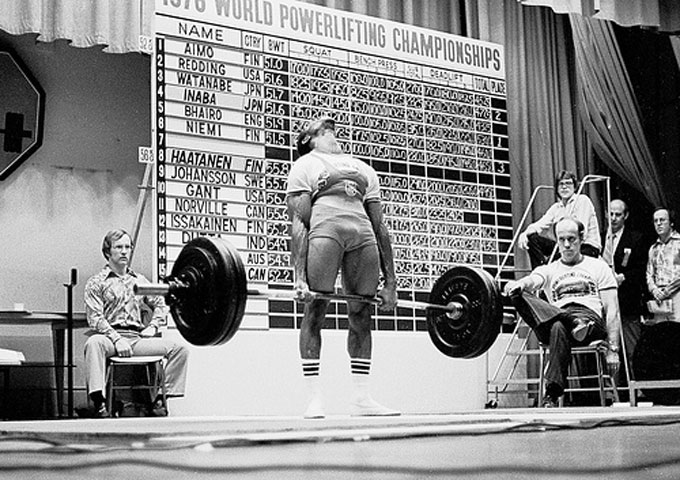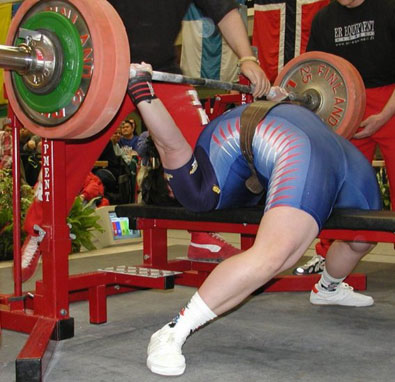One of the more intriguing phenomenons in powerlifting circles is “poverty bench”. Poverty bench simply refers to an individual whose bench strength is largely out of line with their lowerbody strength. This is actually more common than you’d think. At the end of the day, there is really only one cause of poverty bench press though: you don’t have enough muscle. In the rest of this article, I’m going to explain why this happens to powerlifters in particular and what you can do to fix it.
If you’d rather watch than read:
Why You Have a Poverty Bench
As I stated in the article intro, there is only one real reason you don’t have a strong bench press: you don’t have enough upperbody mass. PERIOD. There is no other reason. Once you get that through your head and stop looking for magic programming solutions, you’re already well on your way to fixing the problem. Now, of course, there are some extenuating factors that contribute to this problem for powerlifters in particular.

Here is Eric Spoto, the former all-time world record holder for the heaviest raw bench press, rocking ~20″ forearms. Get big, bench big.
Arm Length and Poverty Bench
The first is that some people have ridiculously long arms.

If you lockout just above your knees on the deadlift, you have super long arms. credit: musclemunch.com
There is nothing you can do about your arm length. If you have super long arms like world recorder Lamar Gant (shown above), you will always have a weaker bench press relative to your deadlift. Your leverages are simply worse for this lift. However, you only compound the problem by staying skinny and not filling out to the proper weight class for your height. At the end of the day, the only thing that can overcome poor leverages is MUSCLE MASS!
You’re too SKINNY!
The second reason that some people REFUSE to gain weight. Look, I get it. In the short term, gaining weight is scary. It makes your Wilks’ score worse, you get fatter, and your numbers don’t look “competitive” at the next weight class up (they’re probably not truly competitive in your current weight class either though, right?). I refused to accept this fact for years. My best bench press as a 67.5kg/148lbs lifter was 242lbs/110kg in competition (I did 265lbs/120kg in the gym once). At 83kg/183lbs, I’ve done 165kg/365lbs touch and go in the gym relatively easily. You have to gain weight.

Bodyweight here was approximately 160lbs. My best bench in training at this size was only 265lbs/120kg and that was not very strict at all. Picture taken in summer of 2014.

Bodyweight here is approximately 190lbs (~14kg BW gained). My best paused bench in training at this size was 355lbs/161kg. Picture taken in summer of 2017. This is THREE YEARS of consistent effort in terms of trying to gain size.
For advice on exactly how to gain weight properly and what your ideal weight class is, check out EatingToWin2.
Partial Range of Motion Benching and Hyperspecificity in Programming
The last reason is that many powerlifters engage in hyperspecific styles of training. They do very little accessory work and almost all of their upperbody volume comes from wide-grip, arched-back bench pressing.

This is not cheating; this is fantastic technique, but it comes at a cost. This tiny, little range of motion isn’t optimal for building muscle mass.
Many powerlifters are actually flexible enough that their elbows never even reach 90 degrees in the bottom position. Essentially, ALL of their competition bench pressing is done with a partial range of motion. This is great for lifting the most weight possible, but this is absolutely terrible for hypertrophy. If you see someone doing quarter squats in the squat rack, you intuitively know this isn’t optimal for their quad growth, right? Whywouldn’t you assume the exact same thing is true for your arched back, partial bench presses? Well, it is true. Face the facts.
If you want to fix this problem without giving up the competitive advantage of your arch, you need to include extended range of motion accessory movements such as flat back benching, closegrip benching, incline benching, dumbbell pressing of all kinds, flyes, machine chest pressing, and any other upperbody exercise that actively seeks more range of motion rather than less. You should be doing BOTH.
Fix Your Poverty Bench
In conclusion, if you want to fix your poverty bench, you need to spend time focusing on hypertrophy. There are two major components to increasing your upperbody hypertrophy as a powerlifter and they are inextricably linked:
1) GAIN WEIGHT. There is no way around this. If you’re too skinny, your bench will show it. If you’re one of the tallest people in your weight class at national level meets, your bench will show it. For advice on exactly how to gain weight properly and what your ideal weight class is, check out EatingToWin2.
2) INCLUDE HYPERTROPHY ACCESSORY WORK if you’re a big arch, wide-grip bencher! This is so crucial. You need to be doing extended range of motion accessory work. Dumbbells are amazing for this purpose but various types of benching including closegrip work, flat back/feet up benching, and incline benching also work extremely well.
Lastly, BE PATIENT! Gaining muscle as a natural lifter takes a seriously long time. It took me three years to put on 30lbs of bodyweight from ’14 to ’17 and as you can see from the pictures, I still gained A TON of fat in the end. This isn’t a fast process. You have to be committed to doing this for YEARS. Don’t succumb to the temptation of being “competitive” in a lighter weight class. You have to gain weight to have a strong bench press. Your poverty bench press is 100% due to the fact you simply don’t have enough muscle mass. PERIOD.
Gain weight.
Like this Article? Subscribe to our Newsletter!
If you liked this articled, and you want instant updates whenever we put out new content, including exclusive subscriber articles and videos, sign up to our Newsletter!
Questions? Comments?
For all business and personal coaching services related inqueries, please contact me: